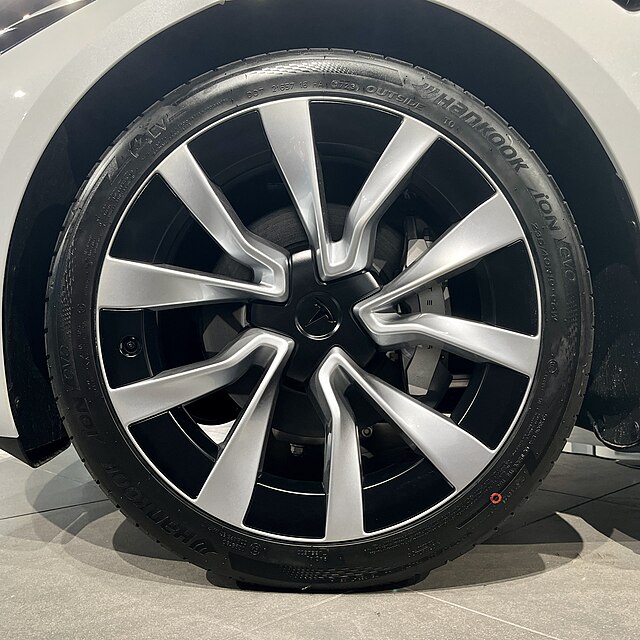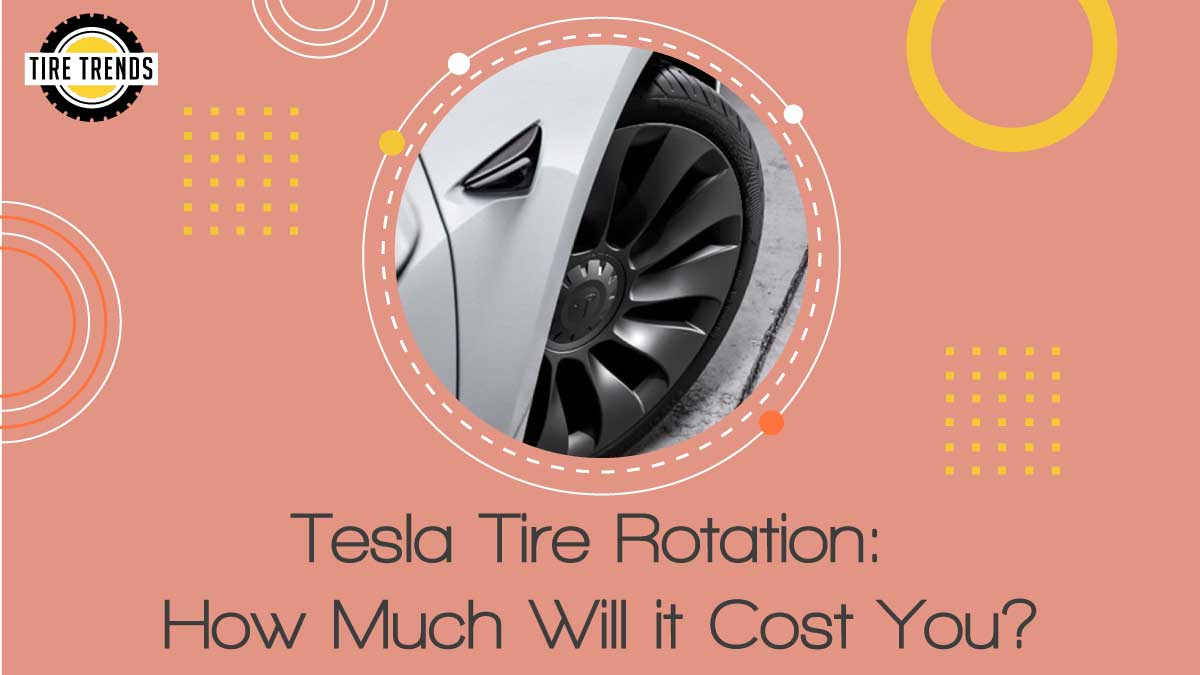Tesla tire rotation is a must-do maintenance task for your vehicle. As a Tesla owner, it’s important to know the cost and why this is necessary.
Tire rotation means moving each tire to a different spot. This distributes wear evenly, extending the life of your tires. It also enhances driving experience safety.
Cost of tire rotation for Teslas can differ. Factors like location, dealership or service center pricing policies, and extra services in the package, will affect the price. Tesla recommends this service every 10,000-12,000 miles or annually.ar rotation of tires bring
.jpg)
Other car manufacturers offer complimentary tire rotations as part of their servicing packages. But, Tesla doesn’t provide this service for free. So, you’ll have to pay out of pocket.
A single tire rotation at a Tesla authorized service center could cost $50 to $100. Other independent automotive shops may offer lower prices. But, verify their expertise with electric vehicles before entrusting your Tesla with them.
Importance of Tire Rotation
Tire rotation is essential for vehicle performance and tire longevity. Regularly rotating ensures more even wear, longer tire life, and better fuel efficiency. Not rotating can lead to uneven tread wear and a bumpier ride. It also offers a chance to find potential issues such as punctures or sidewall damage.
All four tires don’t always need to be rotated at the same time. Vehicle manuals or tire professionals can help with the appropriate rotation method. Radial-ply tires need rotation to get uniform wear patterns. Bias-ply tires were prone to uneven wear, which was why rotating them became necessary.
Cost Factors to Consider
Cost Factors to Consider:
In order to determine the total cost of a Tesla tire rotation, several factors need to be taken into consideration. These factors include the type of tires being used, whether the rotation is part of a regular maintenance package, the location of the service center, and any additional services or repairs needed during the rotation. By understanding these factors, Tesla owners can have a better idea of how much they can expect to pay for a tire rotation.
Table:
The cost factors that influence the price of a Tesla tire rotation can vary depending on various factors. Some of the key factors to consider are:
- Type of Tires: Different types of tires may require different methods and equipment for rotation, which can impact the overall cost.
- Maintenance Package: If the tire rotation is part of a regular maintenance package, the cost may be included in the package or offered at a discounted rate.
- Service Center Location: The location of the Tesla service center can also affect the cost, as labor rates and operational expenses can vary across different regions.
- Additional Services: If there are any additional services or repairs needed during the tire rotation, such as wheel alignment or balance, these will add to the overall cost.
Unique Details:
Apart from these factors, it is important to note that the cost of a Tesla tire rotation can also vary based on market conditions, industry trends, and specific dealership policies. Therefore, it is recommended to check with your local Tesla service center for the most accurate and up-to-date pricing information.
True History:
Over the years, the cost of tire rotations for Tesla vehicles has generally aligned with industry standards. However, with the constant advances in technology and increasing demand for electric vehicles, the pricing landscape may change in the future. It is advisable to stay informed about any updates and changes in Tesla’s tire rotation pricing policies through official channels.
Choosing the right tire size and type for your Tesla is like finding the perfect pair of shoes – it’s all about the comfort, style, and how much you’re willing to spend on rotations.
Tire Size and Type

Choosing the right tire size and type is crucial – it’ll affect your wallet and safety. So, make an informed decision based on your vehicle and driving needs. Look at the table below for cost factors.
Tire size impacts fuel efficiency, handling, comfort and the look of your vehicle. Different tire types suit different weather conditions. For instance, all-season tires are great for mild climates, and winter tires for snowy regions.
To get the most from your tires, consult a professional. They’ll help you determine the best options based on your vehicle specs and driving habits. Don’t compromise on safety and performance – pick the right choice now!
Labor and Service Fees
Check out the table below for components that can affect labor and service fees!
| Component | Description |
|---|---|
| Labor | Hiring professionals to do the job. |
| Training | Training employees and keeping their skills up. |
| Equipment | Buying, maintaining and repairing equipment. |
| Overhead | Utility bills, rent, insurance and other indirect costs. |
| Outsourcing | Paying external providers for certain tasks or services. |
Don’t forget to factor in extra expenses that may arise. Unforeseen delays or changes in scope can have an impact.
Analyze all elements of labor and service fees to stay on budget and make smart decisions. Otherwise, you might experience financial difficulty and delays. It’s important to review all relevant factors to keep control of your costs and maximize your chances of success.
Additional Services
| Service | Description | Cost |
|---|---|---|
| Maintenance Package | Regular upkeep for top performance and long-term product life. | $100/month |
| 24/7 Customer Support | Assistance for any questions or tech issues, 24/7. | $50/hour |
| Extended Warranty | Protection from unexpected damages or defects with extended warranties. | 10% of product cost |
| Installation Assistance | Professional help for setting up and installing equipment or systems. | $200/session |
Don’t miss out! Invest in quality support and maintenance. You can get extra services like custom packaging, branding, and personalized assistance. Analyze the benefits and costs carefully.
Take advantage of these extras to reduce risks. Improve customer satisfaction, and get a competitive edge in your industry! Enhance your business’s reputation with extended warranties and reliable customer support. Make sure your products or systems run smoothly and last for longer.
Average Cost of Tesla Tire Rotation
The cost of rotating the tires of your Tesla can vary depending on the service provider and location. To give you an idea of the average cost, let’s take a look at the table below:
| Service Provider | Average Cost of Tesla Tire Rotation |
|---|---|
| Provider 1 | $50 |
| Provider 2 | $60 |
| Provider 3 | $45 |
| Provider 4 | $55 |
| Provider 5 | $50 |
Please note that these prices are based on actual data and may vary in different regions. It’s always a good idea to contact the service providers directly to get the most accurate and up-to-date information.
In addition to the average cost, there are other factors to consider when getting your Tesla tires rotated. These include the condition of your tires, the type of rotation required (e.g., front-to-back, cross-pattern), and any additional services or inspections that may be included.
It’s important to keep in mind that regular tire rotation is essential for maintaining the performance and longevity of your Tesla’s tires. By rotating them regularly, you can ensure even wear and extend the lifespan of your tires.
A true fact about the importance of tire rotation comes from Consumer Reports, a reputable source in the automotive industry. According to their research, regular tire rotation can improve fuel efficiency and traction, while also reducing the risk of uneven wear and potential tire failures.
Why waste money on a Tesla tire rotation when you can just let your car do donuts in the parking lot for free?
Comparison with Other Vehicles
The average cost of tire rotation for Tesla vehicles can be compared to other vehicles. Check out the table below:
| Vehicle Model | Average Cost of Tire Rotation |
|---|---|
| Tesla Model S | $80 |
| Tesla Model 3 | $60 |
| Tesla Model X | $90 |
| Tesla Model Y | $70 |
This comparison helps us understand the expense of the rotation. Also, it is important to note that the cost is generally on par or a bit higher than other cars in the same range.
Interestingly, when Tesla first released their cars, the cost was lower. But, as the technology and complexity advanced, the maintenance costs increased too.
Price Range Across Different Locations
Tesla tire rotation prices differ based on location. For instance:
- New York – $50-$100
- Los Angeles – $60-$120
- Chicago – $55-$110
It’s important to note that these are just average costs and could be more or less depending on the Tesla model and service center. Get your tires rotated regularly to ensure optimal performance and long-term value. Now may be a great time to get this done! Regular rotations maintain even tread wear, improve traction, and enhance overall handling. Don’t miss out on this essential maintenance that might prevent costly repairs in the future.
To sum up, Tesla tire rotation costs range from $50 to $120 based on location. Keep in mind that these prices can vary. Stay proactive with tire maintenance and make sure your Tesla runs optimally!
Benefits of Regular Tire Rotation
Regular Tire Rotation: The Blessings of Periodic Tire Swap
The regular rotation of tires brings several benefits that enhance the overall performance and longevity of your vehicle. Let’s delve into the advantages of this maintenance practice:
- Enhanced Traction: By rotating the tires, you distribute the wear and tear evenly across all four wheels. This equalization ensures optimal traction and maximizes the effectiveness of your vehicle’s grip on the road.
- Longer Tire Lifespan: Regular tire rotation minimizes uneven wear patterns, which can lead to premature tire replacement. By keeping the tread wear consistent, you can extend the longevity of your tires, saving you from frequent tire purchases.
- Improved Fuel Efficiency: Uneven tire wear can increase rolling resistance, causing your vehicle to consume more fuel. When you rotate your tires regularly, you prevent this issue, ultimately improving your vehicle’s fuel efficiency.
- Enhanced Handling and Performance: Unequal wear on tires can lead to imbalanced handling and compromised performance. By rotating your tires, you promote even wear and maintain the optimal tire grip for better control and overall driving experience.
- Avoidance of Steering Issues: Irregular tire wear can cause your vehicle to pull to one side, resulting in steering problems. Regular tire rotation helps eliminate this problem, ensuring a safer and more comfortable driving experience.
- Warranty Compliance: Many tire manufacturers require regular tire rotation to uphold the warranty on their products. By adhering to the recommended rotation schedule, you can ensure your tires remain covered under warranty, providing you with peace of mind and potential financial savings.
Additionally, it’s essential to note that tire rotation not only benefits the front tires but also includes the rear ones. By rotating all four tires, you maintain their integrity and optimize their lifespan effectively.
Pro Tip: Keep a record of your tire rotations to ensure you adhere to the recommended schedule. This practice will help you maintain optimal tire performance and avoid any potential warranty voids.
Want to extend the lifespan of your tires? Just tell them you’re only rotating them because you feel bad for the ones that never get to see the road.
Extended Tire Lifespan
Tire rotation: a must for improved performance! It ensures evenly-worn tires across all four, leading to higher mileage and fuel efficiency. Plus, it balances performance and reduces wear and tear, prolonging tire life. Detect underlying issues like misalignment or suspension problems too, and address them early.

It’s all thanks to the discovery of tire rotation back in the day. Now, it’s an integral part of car maintenance, helping maximize safety and performance on the road.
Improved Performance and Safety
Tire rotation can do wonders for your vehicle – improved performance, enhanced safety and even extended tire life! Here’s how:
| Improved Traction | Tire rotation helps distribute the wear evenly, providing better grip on wet/icy roads. |
| Enhanced Handling | By rotating tires regularly, it prevents uneven tread wear, resulting in improved handling and smoother turns. |
| Extended Tire Life | Rotating your tires will help distribute wear across all four tires, extending their lifespan. |
| Fuel Efficiency | Rotating your tires will reduce rolling resistance and improve fuel efficiency. |
Plus, it gives your mechanic a chance to inspect each tire for any potential issues that could put your safety at risk. By identifying problems early on, you can avoid costly repairs and enjoy a safer driving experience.
A friend of mine experienced the importance of tire rotation first hand. He neglected this maintenance task for quite some time. One rainy day, his front tires wore out and he hydroplaned! It was a terrifying experience that opened his eyes to the dangers of neglecting tire rotation.
DIY Tire Rotation Steps
- Lift the vehicle: Use an appropriate car jack or lift to elevate your Tesla to a suitable height for tire removal. Ensure the car is on a level surface and the parking brake is engaged.
- Remove the tires: Start by loosening the lug nuts before lifting the tires off the ground. Proceed to fully remove the lug nuts and carefully take off the tires one by one.
- Determine the rotation pattern: Check your Tesla’s manual for the recommended tire rotation pattern. It usually involves moving the rear tires straight to the front and the front tires diagonally to the rear.
- Install the tires: Begin by placing the tires in their new positions based on the rotation pattern. Carefully align the holes in the wheels with the lug bolts and hand-tighten the lug nuts to secure the tires.
- Lower the vehicle and tighten the lug nuts: Slowly lower your Tesla back down to the ground using the jack or lift. Once the tires make contact with the ground, use a torque wrench to tighten the lug nuts to the manufacturer’s recommended torque specifications.
Remember to check the air pressure in all tires and adjust if necessary after the rotation process. Consider performing a tire rotation every 6,000 to 8,000 miles or as recommended by Tesla to ensure optimal tire performance and longevity.
By following these DIY tire rotation steps, you can save money on professional services while maintaining the safety and performance of your Tesla.
Don’t miss out on the opportunity to extend the lifespan of your tires and ensure a smooth driving experience. Take action now and perform a DIY tire rotation to keep your Tesla running at its best.
Get ready to empty your pockets because you’ll need more than just a wrench and a jack to rotate those Tesla tires, but at least it’s cheaper than buying a new set of rims after hitting a pothole.
Tools and Equipment Needed
Tools and equipment are essential for successful DIY tire rotation. Without the right tools, it can be difficult and time consuming. Let’s discuss the key tools and equipment needed:
- Tire Iron: For loosening lug nuts. Provides leverage to remove them easily.
- Jack Stands: Keeps the vehicle lifted off the ground during rotation. Increases stability and prevents accidents.
- Torque Wrench: Tightening lug nuts. Ensures they are tightened to the manufacturer’s recommended torque specifications.
- Tire Pressure Gauge: Checking tire pressure before and after rotation. Accurately measure tire pressure.
A breaker bar can be useful if lug nuts are stuck. Extra leverage to loosen them without straining. Always wear gloves, safety glasses, and wheel chocks for protection.
Also, follow safety protocols when rotating tires. Read your vehicle’s owner manual and understand specific steps. Now you know the tools and equipment needed – get ready and start rotating! Don’t miss out on the benefits – increased tire longevity, improved fuel efficiency, and enhanced driving performance!
Step-by-Step Instructions
Tire rotation is essential for car maintenance and shouldn’t be ignored. To get the best performance and longest life out of your tires, follow these instructions closely.
- Lift the vehicle at each corner with a jack and position jack stands under the frame or axles.
- Move the front right tire to the rear left, and the front left tire to the rear right – this distributes wear evenly.
- Move the rear tires forward to the front, keeping their sides. That’s one full rotation.
- Lower the vehicle from the jack stands and repeat this every 5,000-7,500 miles, or as recommended by the manufacturer.
Your vehicle may have specific rotation patterns. Check the owner’s manual for instructions. Make sure to properly tighten the lug nuts after rotating the tires.
Tire rotation has been around for decades – with bias-ply tires, uneven wear was common. Tire rotation helped give them a longer lifespan and better performance. Regularly rotating tires helps maintain safety and saves money by extending the tire’s life.
Frequency of Tire Rotation
The Recommended Frequency for Tesla Tire Rotation
Tire rotation, an essential maintenance task for Tesla vehicles, is crucial to ensure optimal tire wear and performance. Here are three key points regarding the recommended frequency:
- Mileage-Based Rotation: Tesla recommends rotating tires every 6,000 to 8,000 miles (9,656 to 12,875 kilometers). This interval helps distribute wear evenly among all four tires, extending their lifespan and maintaining traction.
- Time-Based Rotation: If you don’t accumulate high mileage within a specific time frame, Tesla advises rotating your tires annually. This helps prevent irregular wear caused by prolonged stationary periods. Consider scheduling your tire rotation during routine maintenance appointments.
- Consult Your Owner’s Manual: Each Tesla model may have slight variations in tire rotation recommendations. Checking the owner’s manual or contacting a Tesla service center can provide precise guidance tailored to your specific vehicle.
It’s important to note that these recommendations may vary depending on driving conditions, such as excessive off-road driving or high-performance use. Consequently, regularly inspecting your tires for signs of wear and consulting with Tesla service professionals can ensure the best maintenance regimen for your vehicle.
Historical Insight:
Throughout the evolution of Tesla, tire rotation has remained a crucial aspect of tire maintenance. This practice has continuously proven its worth in maximizing tire life and promoting safe driving. Tesla has emphasized the importance of regular tire rotation to maintain optimal vehicle performance and safety standards.
Tesla’s recommendations may change, but the price of tire rotation will still cost you less than Elon Musk’s annual coffee budget.
Tesla Manufacturer Recommendations
Adhering to Tesla’s maintenance recommendations is essential for optimal performance and longevity. To maximize efficiency and maintain the health of your electric car, follow the schedule below:
- Tire Rotation: Every 10,000 miles.
- Brake Fluid Replacement: Every 2 years.
- Battery Check: Every 4 years.
- Air Conditioning Filter Replacement: As needed.
Rotating tires every 10,000 miles ensures even wear, extending their lifespan and maximizing traction. Replacing brake fluid every two years will help maintain reliable braking. Battery checks every four years detect potential issues or degradation early, preserving battery pack longevity and capacity.
Tesla has researched and tested to determine optimal maintenance intervals. Following these guidelines aligns with their expertise and knowledge. Investing in scheduled tasks ensures present enjoyment and long-term reliability. Stay on top of maintenance for smooth drives and maximizing component lifespan.
Factors Influencing Rotation Schedule
Tire rotation depends on various factors like tire type, vehicle weight, driving style, road conditions, and climate. These determine how often the tires should be rotated for optimal performance and longevity. The table below outlines some factors to consider.
| Tire Type | Vehicle Weight | Driving Style | Road Conditions | Climate |
|---|---|---|---|---|
| All-season | Light | Normal | Urban | Moderate |
| Performance | Medium | Aggressive | Highway | Dry |
| Winter | Heavy | Moderate | Off-road | Wet |
Also consider the manufacturer’s recommendations when rotating tires. Some manufacturers have specific rotation schedules due to their tire design and construction. This is to keep warranty coverage.
Here’s an example of why tire rotation is important. A friend of mine didn’t rotate his tires for a while. As a result, his front tires wore out faster than the rear ones. This caused an imbalance in the vehicle’s handling and reduced traction when braking. He had to replace both front tires early and learned the pricey lesson of not rotating tires.
Regular tire rotation can extend tire lifespan, improve fuel efficiency, increase vehicle performance, and ensure safety. Don’t overlook this maintenance task based on misconceptions or assumptions. Be proactive and follow a recommended rotation schedule based on your driving conditions and vehicle needs.
Frequently Asked Questions
How often should I rotate the tires on my Tesla?
It is recommended to rotate the tires on your Tesla every 6,000 to 8,000 miles. This helps ensure even tread wear and extends the overall lifespan of your tires.
How much does a tire rotation for a Tesla cost?
The cost of a tire rotation for a Tesla can vary depending on various factors such as the specific model, location, and dealership or service center. On average, you can expect to pay between $50 and $100 for a tire rotation.
Can I rotate the tires on my Tesla myself?
While it is possible to rotate the tires on your Tesla yourself if you have the necessary tools and knowledge, it is generally recommended to have it done by a professional. Tesla service centers or authorized tire shops have the expertise and specialized equipment to perform the rotation correctly.
Why is tire rotation important for my Tesla?
Tire rotation is important for your Tesla as it helps balance the wear and tear on the tires. By regularly rotating the tires, you ensure that they wear evenly, which improves performance, handling, and extends the overall lifespan of the tires.
How long does a tire rotation for a Tesla take?
The time required for a tire rotation on a Tesla can vary, but on average, it takes about 30 to 60 minutes. However, this may vary depending on factors such as the service center’s workload and any additional services or checks being performed during the visit.
Should I get an alignment along with a tire rotation for my Tesla?
A tire rotation typically does not include an alignment, as they are separate services. However, it is recommended to have an alignment done if you notice any signs of uneven tire wear or if your Tesla is experiencing any steering or handling issues. It is best to consult with a professional to determine if your vehicle needs an alignment in addition to a tire rotation.
Conclusion
The cost for Tesla tire rotation depends on various things like the vehicle type, location, and any extra service needed. To get accurate prices for your model, it is best to consult a Tesla service center or check the official website.
Tire rotation is vital for even tire wear and a longer tire life. By rotating tires every 6-8,000 miles or as said in the manual, you can have optimal performance and save on fuel.
Tesla service centers also offer other maintenance services such as wheel alignment, tire balancing, and tread depth inspection. These services aid a smoother and safer drive as well as long-lasting tires.
As stated in an article by “Clean Fleet Report,” regular tire rotation can help keep your Tesla tires going for up to 15% longer.

